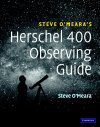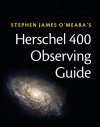![Herschel 400 Observing Guide Herschel 400 Observing Guide]()
Click to have a closer look
About this book
Contents
Customer reviews
Biography
Related titles
About this book
The Herschel 400 is a list of 400 galaxies, nebulae, and star clusters, picked from over 2,500 deep-sky objects discovered and catalogued by the great eighteenth-century astronomer Sir William Herschel and his sister Caroline. It comprises 231 galaxies, 107 open clusters, 33 globular clusters, 20 planetary nebulae, 2 halves of a single planetary nebula, and 7 bright nebulae. In this guide Steve O'Meara takes the observer through the list, season by season, month by month, night by night, object by object. He works through the objects in a carefully planned and methodical way, taking in some of the most dramatic non-Messier galaxies, nebulae, and star clusters in the night sky.
Contents
Preface
Introduction
Part I. Winter:
1. January
2. February
3. March
Part II. Spring:
4. April
5. May
6. June
Part III. Summer:
7. July
8. August
9. September
Part IV. Fall:
10. October
11. November
12. December
Appendix A. Herschel 400 observing list
Appendix B. Herschel 400 checklist
Appendix C. Photo credits
Index
Customer Reviews
Biography
Steve O'Meara earned a Bachelor of Science degree from Northeastern University and has spent much of his career on the editorial staff of Sky & Telescope magazine.The Texas Star Party gave him its Omega Centauri Award for 'advancing astronomy through observation, writing, and promotion, and for his love of the sky,' and the International Astronomical Union named asteroid 3637 O'Meara in his honor. Among his many astronomical achievements, he was the first to sight Halley's Comet on its 1985 return; he noticed the dark 'spokes' in Saturn's B ring before the Voyager 1 spacecraft imaged them; and he was the first person to determine the rotation period of the distant planet Uranus. A superb writer, photographer and naturalist, Steve O'Meara enjoys traveling the world with his wife, Donna Donovan O'Meara, to document volcanic eruptions. Their work has appeared in the National Geographic magazine, and on television. He is sought after internationally for his dynamic lectures on astronomy and volcano topics. Steve is also a contract videographer for National Geographic Digital Motion.
By: Steve O'Meara(Author)
380 pages, 427 b/w photos
"O'Meara takes a list of admittedly faint objects and injects new life into them. Right or wrong, many amateur astronomers won't consider you a top-level observer until you've completed the Herschel 400. Don't do it for them, however. Pick up this book, set up your telescope, and do it for yourself. It's a lot of fun."
– Michael Bakich, Astronomy.com
"If you want to see more obscure objects than those in the Messier catalogue, try the Herschel 400. [...] The book is also well thought out because it looks at the objects on a seasonal and monthly basis. Each month is then subdivided into seven observing nights, ideally near new Moon, that should allow enough time to view all the objects for that month. [...] This book is a great way of pushing beyond the popular Messier catalogue to broaden your viewing horizons."
– BBC Sky at Night Magazine
"[This book] is a far better guide to the Herschel objects than the one available from the AL. It is well presented [...] to be recommended to observers looking for an organized project with medium-sized telescopes after completing the Messier list."
– Owen Brazell, The Observatory
"The Herschel 400 Observing Guide is a very good book, whose main strength is its instructions for locating objects. Even if you are not interested in seeing all of the Herschel 400 objects, I recommend it as a good mid-range guide to the deep sky."
– Lee Macdonald, Journal of the British Astronomical Association
"This book is very nicely produced [...] The layout is very well thought out [...] [O'Meara] works through the objects in a carefully planned and methodical way, ensuring that the minimum of telescope time is employed in locating objects and in moving from one object to the next."
– Alex Crowther, Astronomy and Space
"A good resource for anyone wishing to explore the deep sky."
– Astronomy Now



































